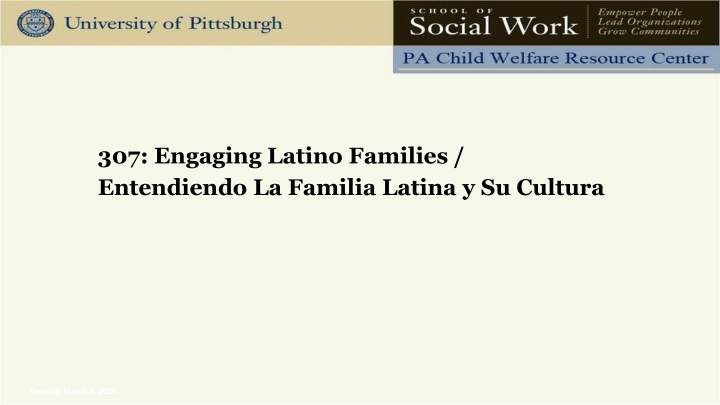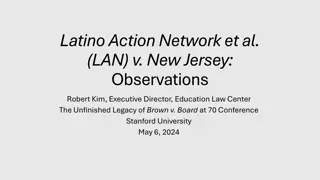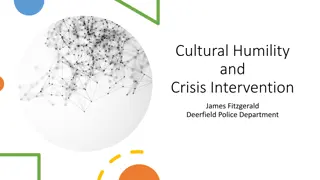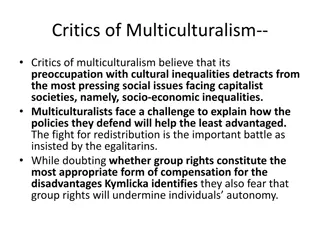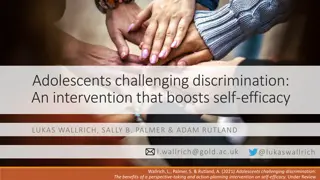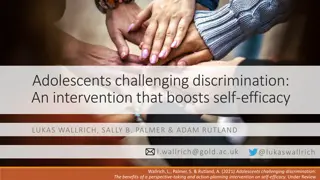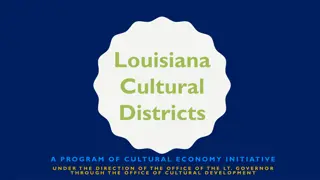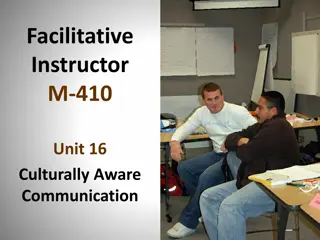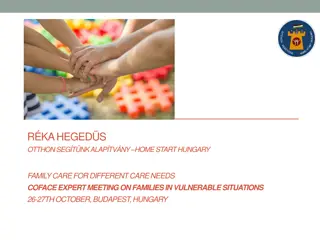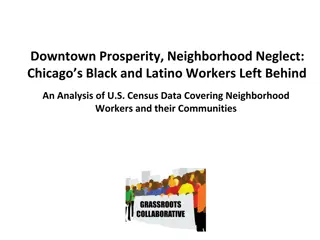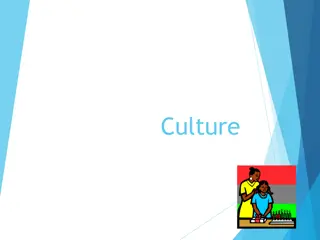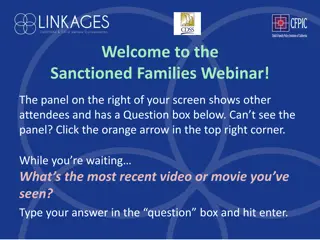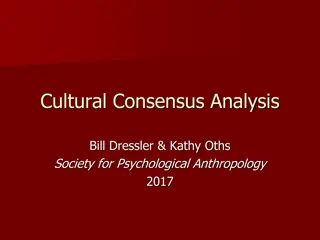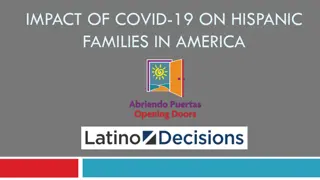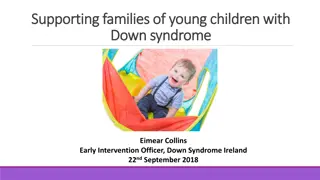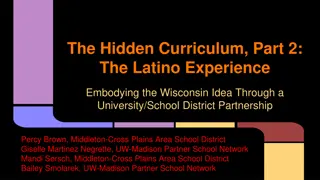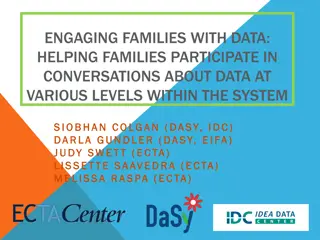Engaging Latino Families: Cultural Insights & Intervention Strategies
Delve into the rich tapestry of Latino cultures to understand family dynamics, immigration history, and parenting techniques. Reflect on personal experiences and perceptions to gain new insights. Discover how to implement culturally appropriate interventions with child welfare clients.
Download Presentation

Please find below an Image/Link to download the presentation.
The content on the website is provided AS IS for your information and personal use only. It may not be sold, licensed, or shared on other websites without obtaining consent from the author.If you encounter any issues during the download, it is possible that the publisher has removed the file from their server.
You are allowed to download the files provided on this website for personal or commercial use, subject to the condition that they are used lawfully. All files are the property of their respective owners.
The content on the website is provided AS IS for your information and personal use only. It may not be sold, licensed, or shared on other websites without obtaining consent from the author.
E N D
Presentation Transcript
307: Engaging Latino Families / Entendiendo La Familia Latina y Su Cultura Tuesday, March 4, 2025
Section para Tarjeta de Presentacion: En el Centro escriba: Nombre En la esquina superior izquierda escriba: Agencia/Condado En la esquina superior derecha escriba: Departamenta/Posici n en su trabajo En la esquina inferior izquierda escriba: Tiempo de trabajo en esta posici n En la esquina inferior derecha escriba: Poblaci n latina a la que m s se sirve en su agencia? Departmenta/Posici n en su trabajo Agencia/Condado Nombre Tiempo trabajando en esta posici n Poblaci n latina a la que m s se sirve en su agencia? The Pennsylvania Child Welfare Resource Center 307: Engaging Latino Families 2
Learning Objectives Participants will be able to: Describe general characteristics of various Latino cultures Define differences between traditional family roles within Latino cultures and Non-Latino culture Be aware of the history of various countries of origin, which impact their cultural values Understand the history and outcomes of Latino immigration to America Explain the discipline and parenting techniques prevalent in various Latino cultures Identify opportunities to implement new knowledge into culturally appropriate interventions with child welfare clients The Pennsylvania Child Welfare Resource Center 307: Engaging Latino Families 4
Reflection Please use this time to reflect on the following: Initial impressions Personal experiences Perception of how Latino families and individuals act the same or differently than you Face what you think you believe and you will be surprised. The real voyage of discovery consists not in seeking new landscapes, but in having new eyes. -- William Hale White -- Marcel Proust The Pennsylvania Child Welfare Resource Center 307: Engaging Latino Families 4
The Pennsylvania Child Welfare Resource Center 307: Engaging Latino Families 5
The Pennsylvania Child Welfare Resource Center 307: Engaging Latino Families 4
History of Migration (http://mapsof.net/south-america/south-america-political-map) The Pennsylvania Child Welfare Resource Center 307: Engaging Latino Families
Mexico Migration 1845 (http://en.academic.ru/pictures/enwiki/77/Mexican_Cession_in_Mexican_View.PNG) The Pennsylvania Child Welfare Resource Center 307: Engaging Latino Families
Naming Conventions First Names Latin Americans traditionally have two first names. For example: Antonio Benjamin, Edison Amilcar, Reinaldo Anibal, Rosa Graciela, Greta Yolanda These names are often associated with religions names, such as Rosario de Jesus (Rosary of Jesus), Maria de los Angeles, Marie de Lourdes, Ana de las Mercedes Some may have three names, after adding a third name during Catholic confirmation Last Names Latin Americans (Mexico, Carribean, Central and South America) are entitled to two last names, with one from each parent The first last name comes from the father, the second last name comes from the mother If a child is an orphan or only has one parent a second last name will be created, perhaps by using the mother s name twice or creating one The Pennsylvania Child Welfare Resource Center 307: Engaging Latino Families 9
Identifying Whos in the Picture Who do I talk to? (male vs. female caseworker) Who lives here? Is that your husband? Are you legally married or living together? Have you always lived here? Where do you come from? Where were you born? How can I understand how your family works? How are decisions made? Who takes care of the children? Who cooks? How do you earn money? What types of bills do you have? Who pays the bills? Where does everybody sleep? For further information on family relationship and other household words, refer to the Audio Dictionary lists in the Resource Manual. The Pennsylvania Child Welfare Resource Center 307: Engaging Latino Families 10
Hidalgos Level of Culture Concrete culture aspects of culture that are tangible and visible, such as clothing, music and food Behavioral culture how we define and organize society, such as social roles, family structure, language and approach to non-verbal communication Symbolic Culture abstract view of ourselves, including values and beliefs and customs (Hidalgo, N. (1993). Multicultural teacher introspection. In T. Perry, & J. Fraser (Eds.), Freedom s plow: Teaching in the multicultural classroom (99-106). New York: Routledge) The Pennsylvania Child Welfare Resource Center 307: Engaging Latino Families 11
Cultural Continuum Each country and region can be generally characterized by value and belief systems, however, this is just a starting point. Each family s values and beliefs are influenced by more than just their cultural group. Other influences may include: Assimilation (rejecting native culture) Acculturation or accommodation (choosing aspects of dominant and native cultures) Transculturation (blending of cultures) Alienation (rejecting the dominant culture) Marginalization (rejecting native culture without connecting to another culture) (Buenaventura https://www.pakeys.org/uploadedcontent/docs/elinpa/ell%20toolkit/cultural%20identity.pdf) The Pennsylvania Child Welfare Resource Center 307: Engaging Latino Families
Geography and Culture The continuum of culture applies to geographical influences as well. Latinos may come from tropical, mountainous, or desert areas. Some are from countries with indigenous populations while others are from areas with more European heritage. Geography affects language as well. Not all Latinos speak Spanish. Latino languages include Spanish, numerous native languages, and Portuguese. (http://etc.usf.edu/maps/pages/5900/5973/5973.htm) The Pennsylvania Child Welfare Resource Center 307: Engaging Latino Families
Potential Conflict Areas Discipline Abuse vs. physical discipline Overcrowded conditions Neglect/Poverty issues School issues Supervision Drug & alcohol use Mental Health Treatment/Services Medical Treatment/Services Placement of a child Comfort object/Cultural surroundings Adherence to MEPA standards Clearances for extended family The Pennsylvania Child Welfare Resource Center 307: Engaging Latino Families 8
Cultural Components in the Casework Relationship Remember to include the following approaches: Determine applicability of traditional values and beliefs to this particular family Become familiar with social behavior rules for the particular sub-group/family culture and abide by them Openly acknowledge cultural differences in the early stages of the relationship and establish a mutually agreed upon way to address misunderstandings Develop an understanding of how the family relates to outside groups and agencies Communicate interest in the family and be willing to understand things from their perspective Use interviewing techniques which frequently clarify meaning, use understandable words/phrases, and encourage feedback Address language differences through use of trained interpreters (Rycus & Hughes. (1998). Field Guide to Child Welfare: Case Planning and Family-Centered Casework, Volume II. Washington, DC: CWLA Press) The Pennsylvania Child Welfare Resource Center 307: Engaging Latino Families 9
The Impact of Culturally Competent Practice Culturally competent practice: Enhances overall communication and facilitates family engagement Allows child welfare professionals to obtain more specific and complete information upon which to form an Assessment Influences how individuals cope with problems and positively affects help-seeking behaviors Increases the likelihood that a Family Service Plan will be adhered to by the family or client system Positively impacts case outcomes The Pennsylvania Child Welfare Resource Center 307: Engaging Latino Families 10
